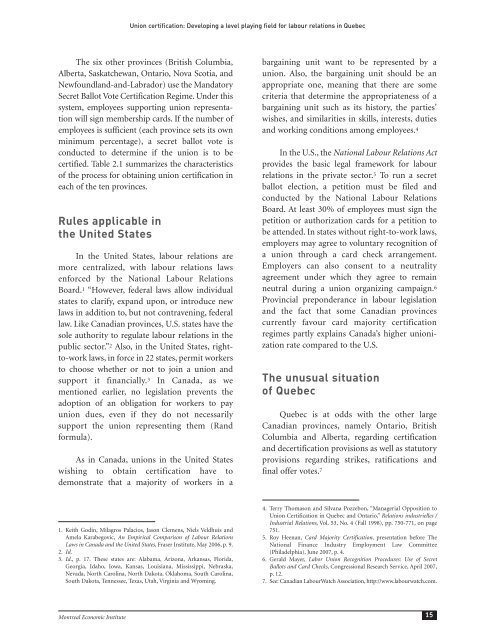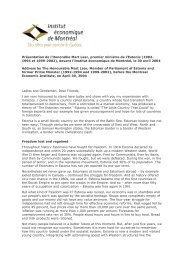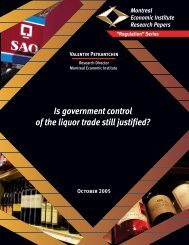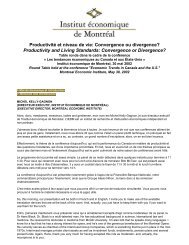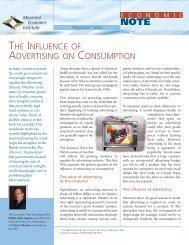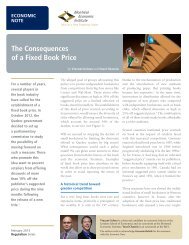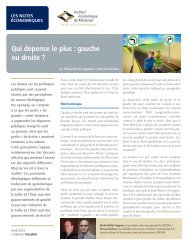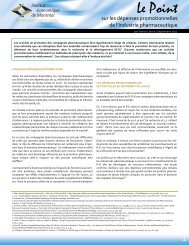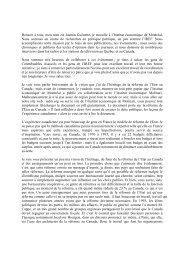Union certification: Developing a level playing field ... - LabourWatch
Union certification: Developing a level playing field ... - LabourWatch
Union certification: Developing a level playing field ... - LabourWatch
You also want an ePaper? Increase the reach of your titles
YUMPU automatically turns print PDFs into web optimized ePapers that Google loves.
<strong>Union</strong> <strong>certification</strong>: <strong>Developing</strong> a <strong>level</strong> <strong>playing</strong> <strong>field</strong> for labour relations in QuebecThe six other provinces (British Columbia,Alberta, Saskatchewan, Ontario, Nova Scotia, andNewfoundland-and-Labrador) use the MandatorySecret Ballot Vote Certification Regime. Under thissystem, employees supporting union representationwill sign membership cards. If the number ofemployees is sufficient (each province sets its ownminimum percentage), a secret ballot vote isconducted to determine if the union is to becertified. Table 2.1 summarizes the characteristicsof the process for obtaining union <strong>certification</strong> ineach of the ten provinces.Rules applicable inthe United StatesIn the United States, labour relations aremore centralized, with labour relations lawsenforced by the National Labour RelationsBoard. 1 “However, federal laws allow individualstates to clarify, expand upon, or introduce newlaws in addition to, but not contravening, federallaw. Like Canadian provinces, U.S. states have thesole authority to regulate labour relations in thepublic sector.” 2 Also, in the United States, rightto-worklaws, in force in 22 states, permit workersto choose whether or not to join a union andsupport it financially. 3 In Canada, as wementioned earlier, no legislation prevents theadoption of an obligation for workers to payunion dues, even if they do not necessarilysupport the union representing them (Randformula).As in Canada, unions in the United Stateswishing to obtain <strong>certification</strong> have todemonstrate that a majority of workers in abargaining unit want to be represented by aunion. Also, the bargaining unit should be anappropriate one, meaning that there are somecriteria that determine the appropriateness of abargaining unit such as its history, the parties’wishes, and similarities in skills, interests, dutiesand working conditions among employees. 4In the U.S., the National Labour Relations Actprovides the basic legal framework for labourrelations in the private sector. 5 To run a secretballot election, a petition must be filed andconducted by the National Labour RelationsBoard. At least 30% of employees must sign thepetition or authorization cards for a petition tobe attended. In states without right-to-work laws,employers may agree to voluntary recognition ofa union through a card check arrangement.Employers can also consent to a neutralityagreement under which they agree to remainneutral during a union organizing campaign. 6Provincial preponderance in labour legislationand the fact that some Canadian provincescurrently favour card majority <strong>certification</strong>regimes partly explains Canada’s higher unionizationrate compared to the U.S.The unusual situationof QuebecQuebec is at odds with the other largeCanadian provinces, namely Ontario, BritishColumbia and Alberta, regarding <strong>certification</strong>and de<strong>certification</strong> provisions as well as statutoryprovisions regarding strikes, ratifications andfinal offer votes. 71. Keith Godin, Milagros Palacios, Jason Clemens, Niels Veldhuis andAmela Karabegovic, An Empirical Comparison of Labour RelationsLaws in Canada and the United States, Fraser Institute, May 2006, p. 9.2. Id.3. Id., p. 17. These states are: Alabama, Arizona, Arkansas, Florida,Georgia, Idaho, Iowa, Kansas, Louisiana, Mississippi, Nebraska,Nevada, North Carolina, North Dakota, Oklahoma, South Carolina,South Dakota, Tennessee, Texas, Utah, Virginia and Wyoming.4. Terry Thomason and Silvana Pozzebon, “Managerial Opposition to<strong>Union</strong> Certification in Quebec and Ontario,” Relations industrielles /Industrial Relations, Vol. 53, No. 4 (Fall 1998), pp. 750-771, on page751.5. Roy Heenan, Card Majority Certification, presentation before TheNational Finance Industry Employment Law Committee(Philadelphia), June 2007, p. 4.6. Gerald Mayer, Labor <strong>Union</strong> Recognition Procedures: Use of SecretBallots and Card Checks, Congressional Research Service, April 2007,p. 12.7. See: Canadian <strong>LabourWatch</strong> Association, http://www.labourwatch.com.Montreal Economic Institute15


